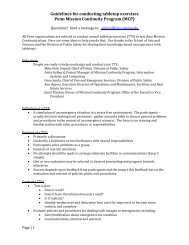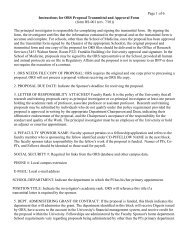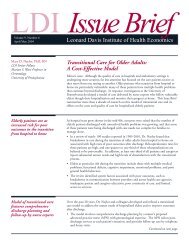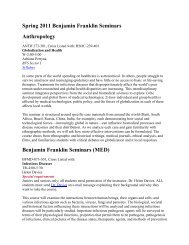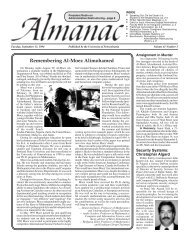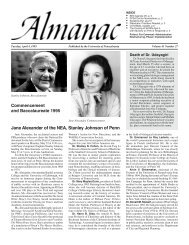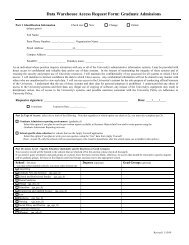2009-2010 COURSE REGISTER - University of Pennsylvania
2009-2010 COURSE REGISTER - University of Pennsylvania
2009-2010 COURSE REGISTER - University of Pennsylvania
Create successful ePaper yourself
Turn your PDF publications into a flip-book with our unique Google optimized e-Paper software.
nomadic cultures and from ancient times to<br />
contemporary participation in the<br />
international market. Iconography, themes<br />
and style will be concered, as will questions<br />
<strong>of</strong> modernity, religious impact, tradition<br />
and colonialism.<br />
210. (CINE223) Post War Japanese<br />
Art. (M) Davis.<br />
Mizoguchi Kenji, Ozu Yasujiro, and<br />
Kurosawa Akira are recognized today as<br />
three <strong>of</strong> the most important and influential<br />
directors in Japanese cinema. In their films<br />
<strong>of</strong> the late 1940s and 1950s, these directors<br />
focused upon issues surrounding the human<br />
condition and the perception <strong>of</strong> truth,<br />
history, beauty, death, and other issues <strong>of</strong><br />
the postwar period. This course will place<br />
their films in period context, and will pay<br />
particular attention to the connections to<br />
other visual media, such as painting,<br />
photography, and printmaking, as well as to<br />
the modern concepts <strong>of</strong> "art" and "history"<br />
in the cinematic context. How three<br />
directors <strong>of</strong> the 1980s and 1990s - Itami<br />
Juzo, Takeshi Kitano, and Miyazaki Hayao<br />
- also took up these issues, and referred to<br />
the "big three" will be disussed at the end<br />
<strong>of</strong> the course.<br />
211. Art in India. (C) Meister.<br />
A survey <strong>of</strong> sculpture, painting and<br />
architecture in the Indian sub-continent<br />
from 2300 B.C. to the nineteenth century.<br />
An attempt to explore the role <strong>of</strong> tradition<br />
in the broader history <strong>of</strong> art in India.<br />
212. (SAST201, SAST501) Indian<br />
Temple Architecture. (C) Meister.<br />
The wooden architecture <strong>of</strong> ancient India's<br />
cities is represented in relief carvings from<br />
Buddhist religious monuments <strong>of</strong> the early<br />
centuries A.D. and replicated in remarkable<br />
excavated cave cathedrals. This course will<br />
trace that architectural tradition, its<br />
transformation into a symbolic vocabulary<br />
for a new structure, the Hindu temple, and<br />
the development <strong>of</strong> the temple in India<br />
from ca. 500-1500 A.D.<br />
213. (EALC157, EALC557) Arts <strong>of</strong><br />
Japan. (K) Davis, Chance. May include<br />
visits to the PMA, <strong>University</strong> Museum, or<br />
other local collections, as available.<br />
This course will introduce the major artistic<br />
traditions <strong>of</strong> Japan, from the Neolithic<br />
period to the present, and teach the<br />
fundamental methods <strong>of</strong> the discipline <strong>of</strong><br />
art history. Our approaches will be<br />
chronological, considering how the arts<br />
developed in and through history, and<br />
thematic, discussing how art and<br />
architecture were used for philosophical,<br />
religious and material ends. Special<br />
attention will be given to the places <strong>of</strong><br />
Shinto, the impact <strong>of</strong> Buddhism, and their<br />
related architectures and sculptures; the<br />
principles <strong>of</strong> narrative illustration; the<br />
changing roles <strong>of</strong> aristocratic, monastic,<br />
shogunal and merchant patronage; the<br />
formation <strong>of</strong> the concept <strong>of</strong> the 'artist'<br />
overtime; and the transformation <strong>of</strong><br />
tradition in the modern age.<br />
L/R 214. (EALC127, EALC527) Arts <strong>of</strong><br />
China. (M) Distribution Course in Arts &<br />
Letters. Class <strong>of</strong> <strong>2009</strong> & prior only.<br />
Steinhardt, Davis.<br />
The goals <strong>of</strong> this course are to introduce the<br />
major artistic traditions <strong>of</strong> China, from the<br />
Neolithic period to the present and to teach<br />
the fundamental methods <strong>of</strong> the discipline<br />
<strong>of</strong> art history. Our approaches will be<br />
chronological, considering how the arts<br />
developed in and through history, and<br />
thematic, discussing how art and<br />
architecture were used for philosophical,<br />
religious and material ends. Topics <strong>of</strong><br />
study will include; Shang bronzes; Han<br />
concepts <strong>of</strong> the afterlife; the impact <strong>of</strong><br />
Buddhism; patronage and painting; the<br />
landscape tradition; the concept <strong>of</strong> the<br />
literatus; architecture and garden design;<br />
the "modern" and 20th-century artistic<br />
practices; among others.<br />
215. Japanese Painting. (M) Davis.<br />
An investigation <strong>of</strong> Japanese painting and<br />
practice from the earliest pictorial<br />
representations through the late twentieth<br />
century. Painting style and connoisseurship<br />
will form the basis <strong>of</strong> analysis, and themes<br />
such as landscape, narrative, and the<br />
expression <strong>of</strong> cultural identities in painting,<br />
will be considered in the context <strong>of</strong> larger<br />
social and cultural issues. Topics include:<br />
tomb painting, Heian development <strong>of</strong><br />
"yamato-e," ink painting and the adaptation<br />
<strong>of</strong> Chinese styles, the expansion <strong>of</strong><br />
patronage in the 18th century, and the turn<br />
toward internationalism in the late 19th and<br />
20th centuries. May include visits to the<br />
PMA or other local collections, as<br />
available.<br />
L/R 216. (ARTH616, EALC227,<br />
EALC627) Chinese Painting. (M)<br />
Distribution Course in Hist & Tradition.<br />
Class <strong>of</strong> <strong>2009</strong> & prior only. Steinhardt.<br />
Study <strong>of</strong> Chinese painting and practice<br />
from the earliest pictorial representation<br />
through the late twentieth century. Painting<br />
style forms the basis <strong>of</strong> analysis, and<br />
themes such as landscape and narrative will<br />
be considered with regard to larger social<br />
and cultural issues. The class will pay<br />
particular attention to the construction <strong>of</strong><br />
the concepts <strong>of</strong> the "artist" and "art<br />
criticism" and their impact on the field into<br />
the present. Visits to look at paintings at<br />
ART HISTORY<br />
the <strong>University</strong> <strong>of</strong> <strong>Pennsylvania</strong> Museum,<br />
PMA and/or local collections will be<br />
<strong>of</strong>fered when possible.<br />
217. Introduction to Visual Culture <strong>of</strong><br />
the Islamic World. (C) Humanities &<br />
Social Science Sector. Class <strong>of</strong> <strong>2010</strong> &<br />
beyond. Holod. Also fulfills General<br />
Requirement in History & Tradition for<br />
Class <strong>of</strong> <strong>2009</strong> and prior.<br />
A one-semester survey <strong>of</strong> Islamic art and<br />
architecture which will examine visual<br />
culture as it functions within the larger<br />
sphere <strong>of</strong> Islamic culture in general.<br />
Particular attention will be given to<br />
relationships between visual culture and<br />
literature, using specific case studies, sites<br />
or objects which may be related to various<br />
branches <strong>of</strong> Islamic literature, including<br />
historical,didactic, philosophical writings,<br />
poetry and religious texts. All primary<br />
sources will be available in English<br />
translation.<br />
218. (ARTH618) Early Modern<br />
Japanese Art and the City <strong>of</strong> Edo. (H)<br />
Distribution Course in Arts & Letters.<br />
Class <strong>of</strong> <strong>2009</strong> & prior only. Davis.<br />
Study <strong>of</strong> the major art forms and<br />
architecture <strong>of</strong> Tokugawa (or Edo) period<br />
(1603-1868). In this course, we will<br />
consider how the arts <strong>of</strong> this era occur<br />
within an increasingly urban and modern<br />
culture, particularly with regard to the city<br />
<strong>of</strong> Edo. Issues <strong>of</strong> the articulation <strong>of</strong><br />
authority in the built environment, the<br />
reinvention <strong>of</strong> classical styles, and<br />
patronage, among others.<br />
May include visits to the PMA,<br />
<strong>University</strong> Museum, or other local<br />
collections, as available.<br />
L/R 220. (CLST220) Introduction to<br />
Greek Art & Architecture. (A)<br />
Distribution Course in Arts & Letters.<br />
Class <strong>of</strong> <strong>2009</strong> & prior only. Haselberger,<br />
Kuttner.<br />
This course surveys Greek art and<br />
architecture, from Sicily to the Black Sea,<br />
between the 10th and 2nd centuries BCE<br />
(Dark Age to Hellenistic). Civic, religious,<br />
and domestic buildings and spaces were<br />
intimately connected with images. These<br />
reange from public sculpture and painting<br />
on and around grand buildings gardens, to<br />
domestic luxury arts like jewelry, cups<br />
vases, mosaic floors. Art and architecture<br />
addressed heroic epic religious and political<br />
themes, and also every-day life and<br />
emotions. Current themes include Greek<br />
ways <strong>of</strong> looking at art and space, and Greek<br />
ideas <strong>of</strong> invention and progress; the role <strong>of</strong><br />
monuments, makers and patrons in Greek<br />
society; and connections with the other<br />
cultures who inspired and made use <strong>of</strong><br />
Page 49





